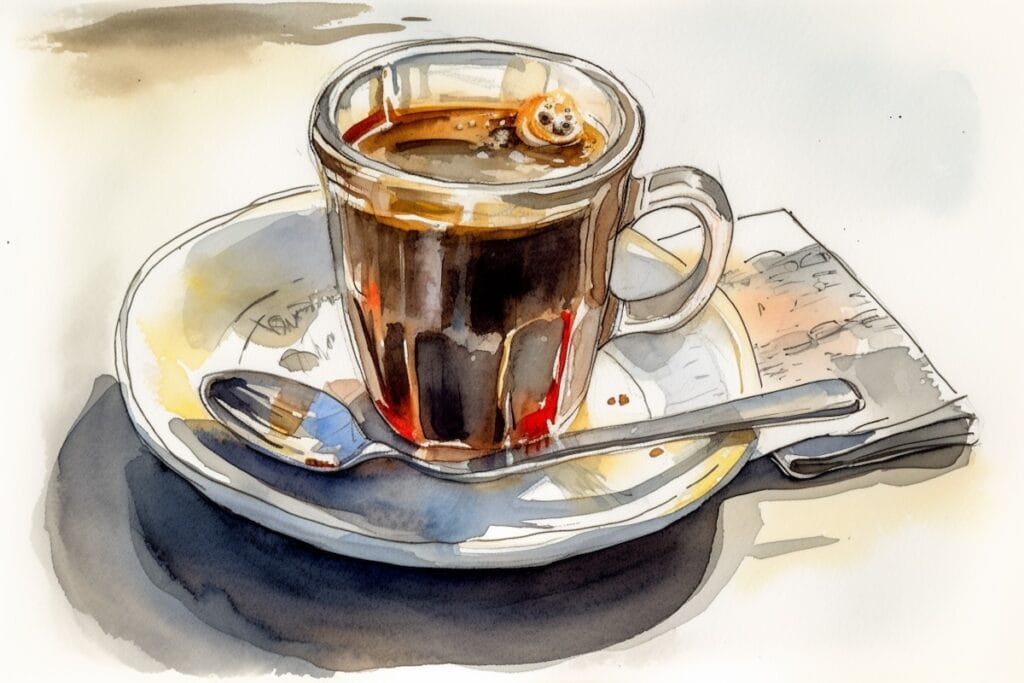How to Reduce Caffeine Intake from an Americano

Understanding the Caffeine Content in an Americano
Are you concerned about the amount of caffeine in your daily Americano? It’s important to know the basics of caffeine and understand how much caffeine is in your favorite coffee beverage. By understanding these factors, you can make informed decisions about your caffeine intake and take steps to reduce it if necessary.
The Basics of Caffeine
Caffeine is a natural stimulant found in various plants, including coffee beans. It stimulates the central nervous system, increasing alertness and reducing fatigue. Many people rely on caffeine to kickstart their day or stay energetic.
While caffeine can provide short-term benefits, consuming too much can negatively affect your health. It’s important to strike a balance and be mindful of your caffeine intake.
How Much Caffeine is in an Americano?
Compared to other coffee drinks, an Americano generally contains less caffeine. An Americano is made by diluting a shot of espresso with hot water. Typically, a single shot of espresso contains approximately 77 milligrams of caffeine.
However, the actual caffeine content can vary depending on the size of the Americano and the number of espresso shots used. This variation makes it crucial to understand the specific caffeine content of the Americano you consume regularly.
Caffeine content is not just about the number of espresso shots. Other factors can influence the caffeine levels in your Americano. For example, the coffee bean type can impact the caffeine content. Robusta beans, commonly used in espresso blends, have higher caffeine levels than Arabica beans.
Furthermore, the brewing method can also affect the caffeine content. The temperature and duration of the water extraction process can alter the amount of caffeine extracted from the coffee grounds. So, even if you order the same size Americano from different coffee shops, the caffeine content may vary based on their brewing techniques.
It’s worth noting that the size of the Americano can significantly impact the caffeine content. If you prefer a larger Americano, you may be consuming more caffeine than you realize. It’s essential to be aware of the size and number of espresso shots in your Americano to gauge your caffeine intake accurately.
Additionally, the strength of the espresso shots can also influence the caffeine content. Some coffee shops offer options for single, double, or even triple shots of espresso. The more shots you add to your Americano, the higher the caffeine content will be.
Lastly, it’s important to consider the brewing ratio when making an Americano. The ratio of espresso to hot water can vary, affecting the overall caffeine concentration. A higher ratio of espresso to water will result in a stronger and more caffeinated Americano.
By understanding these factors and taking them into account, you can better understand the caffeine content in your Americano. This knowledge empowers you to make informed choices about your coffee consumption and adjust your caffeine intake according to your preferences and needs.
Join our newsletter
Watching your caffeine intake? Get the latest brews and caffeine news.The Health Implications of Excessive Caffeine
While enjoying a cup of Americano can be a part of a balanced lifestyle, excessive caffeine consumption can have both short-term and long-term health implications.
Caffeine, a natural stimulant found in coffee, tea, energy drinks, and chocolate, is the most widely used psychoactive substance in the world. It works by blocking the effects of adenosine, a neurotransmitter that relaxes the brain and makes you feel tired. While moderate caffeine intake can temporarily boost energy and improve focus, overconsumption can lead to various health issues.
Short-Term Effects of Caffeine Overconsumption
Consuming too much caffeine can lead to increased heart rate, restlessness, anxiety, and difficulty sleeping. It can also cause digestive issues such as acid reflux or indigestion. These short-term effects can be unpleasant and may disrupt your daily routine.
When you consume caffeine, it stimulates the release of adrenaline, the “fight or flight” hormone. This can result in a rapid heartbeat, making you feel more alert and awake. However, excessive caffeine intake can cause your heart rate to become irregular or even lead to palpitations, which can be concerning for individuals with underlying heart conditions.
Furthermore, caffeine is a diuretic, meaning it increases urine production and can contribute to dehydration. This can lead to symptoms such as dry mouth, dizziness, and headaches, especially if you don’t consume enough water to compensate for the diuretic effects.
Long-Term Effects of Caffeine Overconsumption
Long-term overconsumption of caffeine has been associated with several health problems. Excessive caffeine intake can lead to dependency, making it challenging to function without regular doses. This can result in withdrawal symptoms such as fatigue, irritability, and difficulty concentrating.
Moreover, chronic caffeine consumption can negatively impact sleep quality. Caffeine has a half-life of about 5-6 hours, meaning it takes that long for your body to eliminate half of the caffeine you consumed. If you consume caffeine late in the day, it can interfere with your ability to fall asleep and stay asleep, leading to sleep deprivation and its associated consequences, including decreased cognitive function and mood disturbances.
In addition to its effects on sleep, excessive caffeine intake can contribute to high blood pressure. Caffeine temporarily increases blood pressure by constricting blood vessels and stimulating the release of stress hormones like cortisol. Over time, this can lead to chronically elevated blood pressure, increasing the risk of cardiovascular diseases such as heart attacks and strokes.
Furthermore, caffeine can interfere with the absorption of certain minerals, such as calcium and iron, which are essential for maintaining strong bones and preventing anemia. This can be particularly concerning for individuals who already have low levels of these minerals or are at risk of osteoporosis.
If you regularly struggle with excessive caffeine intake, it’s time to consider strategies to reduce your overall consumption. Gradually decreasing your caffeine intake, replacing caffeinated beverages with herbal teas or decaffeinated alternatives, and ensuring you get enough sleep and stay hydrated are all steps you can take to promote a healthier lifestyle.
Another strategy to lower your caffeine intake is to explore the world of herbal infusions. There are a wide variety of herbal teas available, each with their own unique flavors and health benefits. For example, chamomile tea is known for its calming properties, while peppermint tea can help with digestion. By incorporating these herbal infusions into your routine, you can still enjoy a warm and comforting beverage without the stimulating effects of caffeine.
In addition to exploring alternative coffee options and herbal infusions, another effective strategy is to pay attention to the timing of your caffeine consumption. Instead of starting your day with a strong cup of coffee, consider delaying your caffeine intake until later in the morning. This allows your body to naturally wake up and energize itself without relying on caffeine as a crutch. Additionally, avoiding caffeine in the afternoon and evening can help improve your sleep quality and reduce any potential caffeine-related insomnia.
Furthermore, it can be helpful to identify the underlying reasons behind your caffeine consumption. Are you using caffeine as a way to combat fatigue or boost your productivity? If so, there may be other lifestyle changes you can make to address these issues. For example, incorporating regular exercise into your routine can naturally increase your energy levels and improve your overall well-being. Additionally, practicing good sleep hygiene, such as establishing a consistent bedtime routine and creating a sleep-friendly environment, can help you feel more rested and reduce your reliance on caffeine.
Lastly, it’s important to remember that reducing your caffeine intake is a personal journey. What works for one person may not work for another. It’s important to listen to your body and make adjustments accordingly. If you experience severe withdrawal symptoms or find it difficult to cut back on caffeine, it may be helpful to seek guidance from a healthcare professional who can provide personalized advice and support.
In conclusion, there are several strategies you can employ to lower your caffeine intake. By gradually reducing your caffeine consumption, exploring alternative coffee options and herbal infusions, paying attention to the timing of your caffeine consumption, addressing underlying reasons for caffeine consumption, and seeking professional guidance when needed, you can successfully reduce your reliance on caffeine and improve your overall well-being.
Dealing with Caffeine Withdrawal Symptoms
Lowering your caffeine intake may lead to withdrawal symptoms as your body adjusts to the change. While these symptoms can be uncomfortable, they are temporary and can be managed effectively.
Common Symptoms of Caffeine Withdrawal
Withdrawal symptoms can include headaches, fatigue, irritability, and difficulty concentrating. It’s important to remember that these symptoms are a sign that your body is adjusting to the reduced caffeine intake and should subside over time.
Tips to Manage Withdrawal Symptoms
To alleviate caffeine withdrawal symptoms, ensure you stay hydrated, get enough rest, and incorporate gentle exercises into your routine. Drinking herbal teas or consuming foods that boost natural energy levels, such as fruits and nuts, can also help ease the transition.
Maintaining a Low-Caffeine Lifestyle
Once you’ve successfully reduced your caffeine intake, it’s essential to maintain a low-caffeine lifestyle in the long run. Here are some healthy habits to incorporate:
Healthy Habits for Low-Caffeine Living
Enjoy a balanced diet, exercise regularly, and prioritize quality sleep. These foundational habits will help you maintain natural energy levels throughout the day without relying on caffeine.
Monitoring Your Caffeine Intake
Even after reducing your caffeine intake, it’s important to stay aware of how much caffeine you’re consuming. Keep track of your coffee and tea consumption, read labels on packaged foods, and be mindful of hidden sources of caffeine. By monitoring your intake, you can make adjustments and maintain a low-caffeine lifestyle.
Reducing your caffeine intake from an Americano can be a positive step towards achieving a healthier lifestyle. By understanding the caffeine content, being aware of the health implications of excessive consumption, and implementing effective strategies, you can take control of your caffeine intake and enjoy the benefits of a balanced life.


